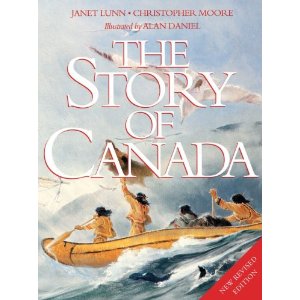Although relatively short and peaceful, Canada’s history is both fascinating and significant. Our family owns all kinds of Canadian history books, but for a readable overview that appeals to all ages we prefer The Story of Canada by Janet Lunn and Christopher Moore.
This large, colorful book is full of detailed illustrations and interesting stories as well as basic Canadian history. In ten chapters it goes from the earliest times to the year 2000, telling Canada’s story in words, photographs, many fascinating inserts, and cheerful illustrations that sometimes cover two full pages. It is obviously the work of a team: Janet Lunn, a well-recognized children’s author; Christopher Moore, a distinguished historian; and Alan Daniel, a gifted illustrator.
Besides outlining the history quite thoroughly, The Story of Canada also provides innumerable incentives to learn more about an explorer, a time, a place, a hero, or a way of life. The first part of the book is organized in an east-west direction, but once all the land is explored and Canada has become a country, each chapter includes the whole country. To help tie all the events together, the back of the book features a detailed chronology.
What we really enjoy:
- The Story of Canada is lavishly illustrated and full of human interest. The chapters are coherent and the information is well-organized and easy to remember. One of my girls, then in grade 6, happily wrote a report for each chapter and learned an enormous amount about both Canadian History and writing.
- Although it is written for young people, this book appeals to all ages. It’s a fascinating refresher on our history for Canadian teens and adults as well as an introduction to our history for those from other countries.
Negative points:
- At over 300 large pages, this book can be physically intimidating. Miss 11 asked to be allowed to read a smaller book instead, and I can imagine she isn’t the only 11-year-old who would respond that way.
- As is to be expected from a secular history book, The Story of Canada assumes long ages and evolving people, but it is not strident about these concepts and covers them in less than ten pages.
- The Story of Canada is fairly politically correct. Radical environmental activism, feminism, and non-Christian spirituality are given more space than is historically mandated, and somewhat more approval than I would wish. This is usually done subtly and most children will not realize what is going on, providing parents with an excellent chance to point out author bias and presuppositions.
Each of these negative points is minor and can be seen as a teaching opportunity.
I reread The Story of Canada just this autumn to refresh my memory as we embark on a two-year journey through Canadian history. It was inspiring and now I have a whole list of topics to explore further. I also loved Alan Daniel’s beautiful paintings throughout the book. They are warm, detailed, and full of action and emotion, truly among the best features of this book.
Miss 13 also recently reread it. She told me it’s full of useful information and interesting tidbits. She also pointed out that it does not spend too much time on Quebec like some Canadian history books do. Note that she reread it without being asked to. The Story of Canada is like that, a living book rather than a textbook.
Our family recommends The Story of Canada to anyone looking for a lively introduction to Canada’s history. We’re not the only ones who like it; according to Amazon.ca it is the most successful children’s book ever published in Canada.
The Story of Canada is one of the overviews we use in our multi-year, literature-based Canadian History course.
Disclosure: We have owned this book for many years and as usual, are not compensated for this review.


hi wondering what the first chapter is called? is it a hundred centuries? I have a study guide for a book called the story of Canada, but there are more than one books by that name. thanks for your help!